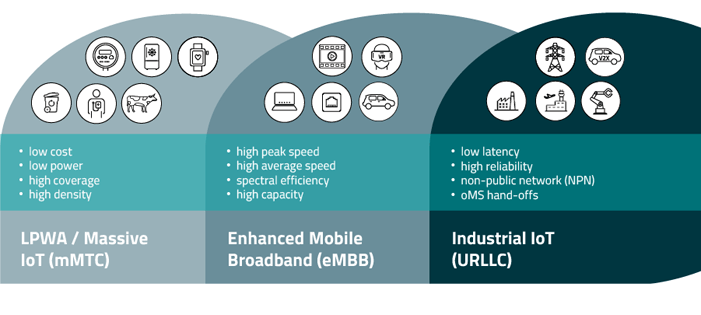July 25, 2019

Related Blogs:
Sign up for blog updates
Get innovation delivered to your inbox. Sign up for our blog and stay on top of the very latest from Semtech (formerly Sierra Wireless).
July 25, 2019

Since launching the world’s first cellular embedded module in 1997, Sierra Wireless has realized an impressive series of IoT milestones. From its introduction of the first wide area network interface card in 1999, to being first to market with LTE embedded modules in 2010, to the release of its first dual-mode LPWA module and first LTE Advanced Pro module in 2017, Sierra Wireless has consistently been a pioneer in delivering customers innovative IoT solutions that empower them to thrive in an increasingly connected economy.
Earlier this month at its 5G innovation lab in Canada, Sierra Wireless marked another IoT milestone when it completed a 5G IoT data transmission for the first time. The test was conducted using the same M.2 form factor 5G module engineering sample, featuring Qualcomm’s Snapdragon X55 5G modem chipset, that Sierra Wireless first unveiled at Mobile World Congress in February.
During the test, Sierra Wireless established data connectivity in the sub 6 GHz band, using testing equipment from Anritsu and Rhode & Schwartz. Over the coming months, Sierra Wireless plans to expand testing of its other 5G IoT modules, including completion of even faster data transmissions using 5G’s mmWave 26 GHz to 39 GHz bands.
Sierra Wireless is already working with Original Equipment Manufacturers (OEMs), system integrators, and other customers to integrate Sierra Wireless’s upcoming 5G modules into their mobile computing, networking, and IoT products. These products will benefit from 5G’s multi-Gigabit data transfer speeds, lower latency, and ultra-high reliability. Customers are considering how they can use Sierra Wireless 5G modules for new use cases that go beyond what is possible today with 4G technologies, including new 5G IoT solutions in the following areas:

Why are companies turning to Sierra Wireless to help them develop mMTC, eMBB, URLLC, and other 5G IoT applications? Multiple reasons.
For starters, Sierra Wireless is developing 5G modules that allow companies to use whichever 5G technology best fits their use case, be it mmWave, sub 6 GHz, or LTE. It also has industry-leading IoT experience, having worked with thousands of customers around the world to build, implement, and securely manage large-scale IoT application deployments across technologies from 2G to 4G. It possesses deep levels of 5G expertise, having helped direct the evolution of 5G as an active contributor to the GSMA Working Group, 3GPP standards bodies, and other industry organizations. And, as mentioned earlier, it has a 25-year track record as an IoT pioneer, having been first to market with several 4G and LTE technologies. This cellular connectivity DNA allows Sierra to guide its OEMs and other customers through the unique technical challenges involved in producing a 5G enabled device.
Last week’s successful 5G IoT data transmission represents another pioneering step forward for Sierra Wireless. We look forward to further steps that drive the transition from 5G’s final standardization to its full commercialization, and working closely with our customers to help them evaluate their 5G options, develop their 5G plans, and build new 5G IoT solutions that transform how the world works, plays, and lives.
Watch our webinar 5G for IoT: Beyond the Hype, read our white paper 5G for IoT? You’re Just in Time, and Start With Sierra to learn more about how you can develop new 5G IoT applications that reimagine your future in today’s connected world.
Get innovation delivered to your inbox. Sign up for our blog and stay on top of the very latest from Semtech (formerly Sierra Wireless).